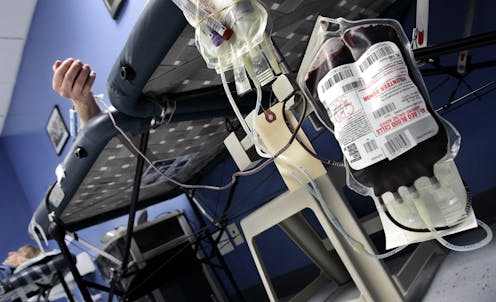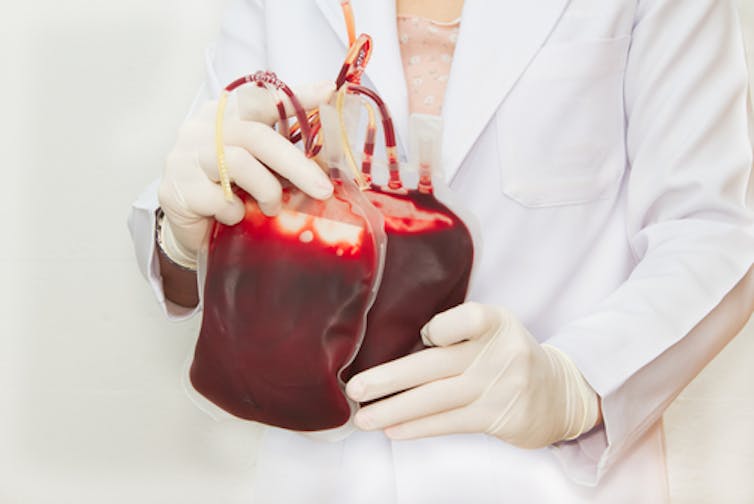How game theory could help ensure you will get blood when you need it
The US is once again experiencing a shortage of blood, a difficult commodity to ship because it is perishable and time-sensitive. Here's how game theory could help solve the problem.

Blood shortages in the United States are now at the critical level because of severe weather nationally, coupled with widespread flu. Hundreds of blood drives have been canceled this winter, and the donor base has decreased because of illnesses as well as difficulties encountered in reaching collection sites due to bad weather. The Red Cross is reporting that blood donations are being distributed to hospitals “faster than they are coming in.”
As in all industries, there are networks, known as supply chains, consisting of suppliers, processors and distributors, that get a product – in this case blood – to the health care providers for the patients in need. But the blood supply chain is not your typical supply chain.
Blood service organizations, usually nonprofits, compete for donations, since blood (unlike most other products) cannot be manufactured but must be voluntarily donated. The blood then undergoes testing at sites, which can be far removed from the collection locations. Then it is processed and stored, before ultimately being distributed to hospitals and other medical facilities.
Blood is a perishable, time-sensitive product. Red blood cells (RBCs) have a shelf life of only 42 days, and blood must be kept within the correct temperature range and conditions from the time it is collected from blood donors to the point of transfusion to patients. Moreover, even under ideal circumstances, although 38 percent of the U.S. population is eligible to donate blood at any given time, fewer than 10 percent actually donates blood in a given year.
My research team and I at the Isenberg School of Management at UMass Amherst have been studying supply chains for nearly two decades. Our work has yielded insights into commercial supply chains of profit-maximizing firms and supply chain disruptions. Currently, we are investigating the volatile health care landscape, including the growing competition among nonprofits, from hospitals to blood service organizations.
What makes blood supply chains unique
Blood service organizations compete for blood from donors on the supply side and with one another on the demand side in providing the blood to hospitals and medical facilities. About 36,000 units of RBCs alone are needed every day in the U.S., with the Red Cross supplying about 40 percent of the nation’s blood. America’s Blood Centers, with 600 blood donor centers, provide about 50 percent of the blood in the U.S. and about one-quarter of the blood in Canada.
Major hospitals often have their own blood collection and testing facilities, but they still may have contracts with blood service organizations to maintain an adequate supply and to be able to respond in the case of a major disaster. Blood is transported using different modes of transportation, usually by courier, and using the most efficient route. If the demand is thousands of miles away, then an air courier, including UPS and FedEx, does the transport.

The changing dynamics in the blood industry, which have included an increase in the number of mergers and acquisitions and the closure of testing facilities, is forcing blood service organizations to be more innovative in conducting their business. Blood service organizations must price their products competitively based on the supplied quantity in order to recover costs of their operations and to generate revenue for activities such as the research and development required for providing a steady supply of safe blood.
Taking all these factors into account, coupled with critical shortages due to illnesses and weather, and other seasonality issues, there is a need for a change in blood supply chain management. The new supply chain management model should take into account not only the well-defined problems of perishability, outdating, shortage and wastage, but also the limits on supply capacity, as in the case of the critical shortages this winter and competition among blood banks. My colleagues and I who study game theory believe that game theory can be a powerful tool in assisting decision-makers in assessing and addressing critical blood shortages.
Game theory analytics
Game theory is a powerful methodology with major contributions made by John Nash, a Nobel laureate in economics. It allows for the math modeling of interactions among competing or cooperating decision-makers, who are faced with their own objectives and also constraints on resources. Game theory has been used in numerous disciplines but its applications to health care have been only limited and fairly recent; see for example, an application to a hospital competition. We have also shown that game theory can provide more effective disaster relief.
Our new blood supply chain game theory model captures competition for blood donations on the supply side as well as competition for business on the demand side. The computer-based model includes capacities on supply chain activities such as testing, storage and distribution, which can be adjusted based on various scenarios. It also includes the capacities associated with the number of available donors in different regions.
In order to minimize wastage at demand sites, we allowed for lower bounds as well as upper bounds on the volume of RBCs needed at each hospital demand point. Perishability is handled using multipliers to capture how much blood may be lost due to, for example, results from testing, as it moves down different pathways from origin nodes to destination nodes.
The algorithmic solution of the game theory supply chain network model yields optimal blood flows plus the prices that should be charged for cost recovery. Since the blood service organizations are nonprofits and interested in doing good, we also included an altruism component in their objectives, while satisfying, as best as possible, the demand. The flexibility of the game theory model allows the decision-makers to evaluate the impacts of a reduction (or increase) in the donor availability and to determine the impacts on blood flows and the prices charged, as well as revenues incurred by the competing blood service organizations.
In our study, we found which blood service organization is affected the most in the presence of various supply chain disruptions. That includes a disruption in terms of the donor base due to a disease and disruptions to testing and storage facilities as may happen in a natural disaster. The evaluation of different possible scenarios enables the blood service organizations to be more prepared and resilient.
Furthermore, as the results in another study of ours have shown, new partnerships over geographical distances – which would correspond to cooperative behavior – can provide significant benefits to blood service organizations, hospitals, as well as patients in the case of a disaster and an accompanying demand surge, as occurred post-Hurricane Maria, which devastated Puerto Rico.
The same study provides quantifiable measures for the identification of possible synergies for blood service organizations through alliances. Alliances can result in cost reduction in operations, the reduction of costs associated with possible blood shortages, and even supply surpluses, which result in waste. They can enable the most cost-effective sharing of resources and making the most of the available blood.
Anna Nagurney does not work for, consult, own shares in or receive funding from any company or organization that would benefit from this article, and has disclosed no relevant affiliations beyond their academic appointment.
Read These Next
How to reduce gift-giving stress with your kids – a child psychologist’s tips for making magic and a
Depending on family circumstances and a child’s personality type, gift giving runs the gamut of fun…
The world risks forgetting one of humanity’s greatest triumphs as polio nears global eradication − 7
Polio may finally be defeated in the next 5 years. Will the world recognize what an extraordinary achievement…
Medieval peasants probably enjoyed their holiday festivities more than you do
The Middle Ages weren’t as dreary and desperate as you’d think, and peasants often had weeks of…





